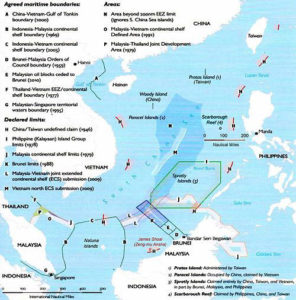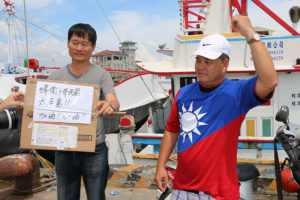The People’s Republic of China’s (PRC) South China Sea (SCS) claims, including the Nine-Dash Line, derive entirely from those of its predecessor regime, the Republic of China. To this day, the Republic of China (Taiwan) has not resiled from any of these claims. Indeed, the Taiwanese claims are slightly larger, as they include the original Eleven-Dash Line, as drawn in 1947. The PRC subsequently reduced this by ceding a part of Taiwan’s original claim to its fellow communists in Vietnam. Taiwan, both before and after 1949, has remained in effective control, including a military garrison, of the Dongsha/Pratas archipelago, to which there are no ‘non-Chinese’ claimants. It also occupies and garrisons the single largest feature of the contested Spratlys — Taiping Island (Itu Aba).
Former president Ma Ying-jeou 马英九 and his Kuomingtang (KMT) administration pursued these claims (and similarly Taiwan’s claims in the East China Sea, particularly the Diaoyutai [Diaoyu in PRC parlance]/Senkaku islands), with considerable vigour. A major and long-running exhibition devoted to the Taiwan’s SCS claims was mounted in Taipei in 2015, accompanied by a very substantial publication issued by the Ministry of the Interior, titled Compilation of Historical Archives of the Southern Territories of the Republic of China 中華民國南疆史料選集.
At the same time, Ma sought to promote his own plan for the peaceful resolution of the various SCS territorial disputes, and despite the virtual identity of Taiwan’s and the PRC’s claims, refused to join any form of united front with the PRC against other claimants. In the closing months of his presidency, Ma was also very active in seeking to establish the identity of Taiping Island as an island in fact and not just name (with consequent implications under the UN Convention on the Law of the Sea for its own 200-nautical-mile Exclusive Economic Zone). He himself visited Taiping Island, with a large contingent of journalists, attracting criticism from the US, which saw his actions as ‘extremely unhelpful’.
Due to Taiwan’s lack of international recognition as a sovereign state, it was not able to participate in the arbitration proceedings of the UNCLOS tribunal launched by the Philippines against the PRC, although a submission was made to the tribunal by a non-governmental group of lawyers arguing the case for Taiping Island. The tribunal rejected virtually all of the PRC’s, and hence Taiwan’s, historic claims regarding the SCS (but did not rule on the sovereignty of the various features within the SCS). It also found that Taiping Island was not, in fact, an island, but only a ‘rock’, therefore excluding claims to the exclusive use of its territorial sea and fishing waters. The tribunal’s findings attracted fury from both ‘blue’ and ‘green’ camps in Taiwan, specifically over the nature of Taiping Island, and more generally for the perceived lack of respect shown to Taiwan by the tribunal, in particular its reference to the ‘Taiwan authority of China’.
Despite this reaction, many expected that the newly elected Democratic Progressive Party (DPP) administration of President Tsai Ing-wen would take a much softer line regarding the SCS, given its greater stress on Taiwan per se rather than issues tied up with the historic attributes of the Republic of China. However, this has not been the case. Tsai rejected the tribunal’s ruling, saying it ‘severely infringed’ Taiwan’s SCS rights, and despatched a frigate (which she briefly boarded) to patrol the SCS as a reaffirmation of Taiwan’s determination to defend its national interests. Subsequent activities have included a visit to Taiping Island by a flotilla of fishing boats in late July, and by the Interior Minister in mid-August.
On 29 November, the Taiwanese Coast Guard Administration conducted a humanitarian assistance and disaster relief operation on Taiping Island and surrounding waters. The exercise involved three aircraft, eight vessels, and 336 personnel. Apart from the Coast Guard, participants included contingents from the Ministries of Transportation and Communications, National Defence, Health and Welfare, and the National Rescue Command Centre. The official press release from the Ministry of Foreign Affairs said this took place in accordance with President Tsai’s SCS policy, which consists of the following four points:
- Disputes in the SCS should be peacefully resolved in accordance with international law and the law of the sea, including UNCLOS.
- Taiwan should be included in multilateral mechanisms aimed at settling disputes.
- Countries concerned should have an obligation to ensure the freedom of navigation and overflight in the SCS.
- Disputes in the SCS should be resolved by shelving disputes and promoting joint development.
Vietnam protested against the exercise, saying it was illegal, leading to a reaffirmation of Taiwan’s sovereignty over Taiping Island by a Taiwanese spokesman, while the Director-General of the Coast Guard Administration has not ruled out a visit by President Tsai in the future, ‘if it becomes necessary’.
It remains to be seen with what vigour Tsai and her administration will continue to prosecute Taiwan’s SCS claims, but, for the time being, she has avoided being outflanked by the KMT opposition on the issue, and similarly avoided further aggravating cross-Strait relations. In the eyes of the PRC, any weakening of support for ‘China’s’ — however interpreted — sovereignty would be seen as a move towards Taiwan independence.




